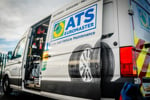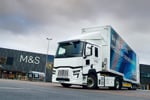
CELEBRATING its 100th birthday this year, the AA has faced some tough challenges during its time trying to keep motorists on the road.
Confronting these challenges effectively has helped the AA concentrate on what it does best – getting motorists back on the road, often within minutes.
David Wallace, director for business services at the AA, operates a clear-cut strategy which can be implemented when things are not always going as planned for fleets.
He said: ‘In business we look at whether there is a market for a service and if we can invest in it.
‘If the answer were no, then we would look at closing the business down, such as with AA Tyre Fit. Our core business is roadside and we concentrate on making this better.’
This no-nonsense approach and ability to deliver a first class fleet service are some of the reasons the AA secured a Fleet News accolade for the third consecutive year. Beating off competition from 70 other companies, the AA was voted as Service Company of the Year by Fleet NewsNet users this year. It also scooped the Enterprise rent-a-car-sponsored Best Breakdown Service Company Award.
Winning the awards has been welcomed throughout the AA, filtering down to frontline patrol staff.
Wallace said: ‘We were shocked when we won the Service Award but it is a fantastic achievement as it is independently measured.
‘It has been a big boost to morale for the business, especially for the frontline staff who deliver the service, such as the patrols and the car handlers.
‘The number one indicator of customer satisfaction is fixing cars at the roadside. We believe we won the award because we do this.’
Fleet customers get exactly the same treatment from the AA as retail customers but Wallace is aware of the pressures on company car drivers to get back on the road as quickly as possible.
‘We don’t treat fleets differently to consumers but, with fleet drivers, time is money so getting the vehicle fixed immediately is acknowledged as being crucial,’ Wallace said.
New technology is helping the AA achieve this more efficiently than ever. It has introduced new VixEN technology which enables patrols to complete on-board diagnostics testing.
The roadside patrol will plug a diagnostic testing unit into a vehicle enabling the repairer to locate and fix a fault more effectively.
The AA has invested millions of pounds in the diagnostics system which Wallace believes is essential to move forward.
‘You can never stand still in the market. When you ignore demand is when you fall behind,’ he said.
Wallace is planning to improve the offering to fleets even further this year with enhanced call centre operations, an overhaul of its accident management package and a new payment card.
He said: ‘We have invested in training and technology to ensure we are more customer friendly on the telephone. We are becoming more human rather than a machine.
‘Call handlers will have refreshed scripts and service training which gets call handlers to put themselves in the customer’s shoes. This ensures the handlers get more accurate information and it is these small changes which make a difference.’
The AA is also re-launching its accident management programme with an improved offering for fleets. This includes a wider network, the availability of smart repairs through a link with Dent Wizard, online access to information and the status of jobs and an online assessment tool for risk management.
The third key focus for Wallace will be the introduction of a new fleet payment card called Fleet Advantage.
This will enable fleets to pay for all motoring related expenditure at the AA, including breakdown, fuel and maintenance. This should be available later this year.
10 facts fleets may not know about the AA
What the judges said
WITH a huge patrol network, fast call-out times, vast range of services and constant innovation, the AA deservedly retains the award this year.
Clever new services include a business mobility package, where the AA will call all forward booked appointments of a driver who has broken down to explain why they are delayed and a time sensitive traveller service, ensuring the customer gets to a key appointment first if a car can’t be put back on the road. Brilliant live online quotation system for business breakdown cover saves fleets time, potentially part of the reason for its very high customer satisfaction rating.
David Wallace: profile















Login to comment
Comments
No comments have been made yet.